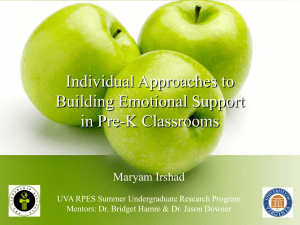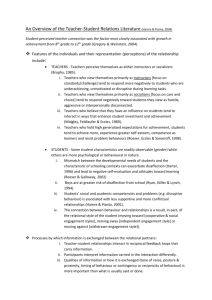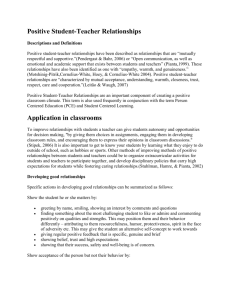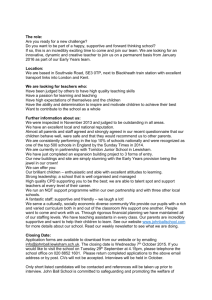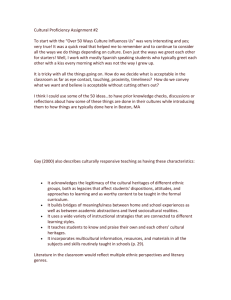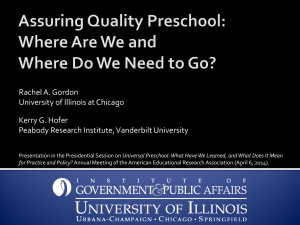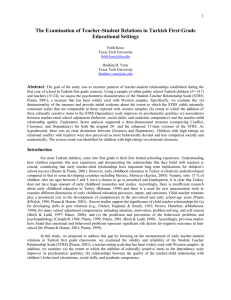Wise Ways The environment of the school
advertisement
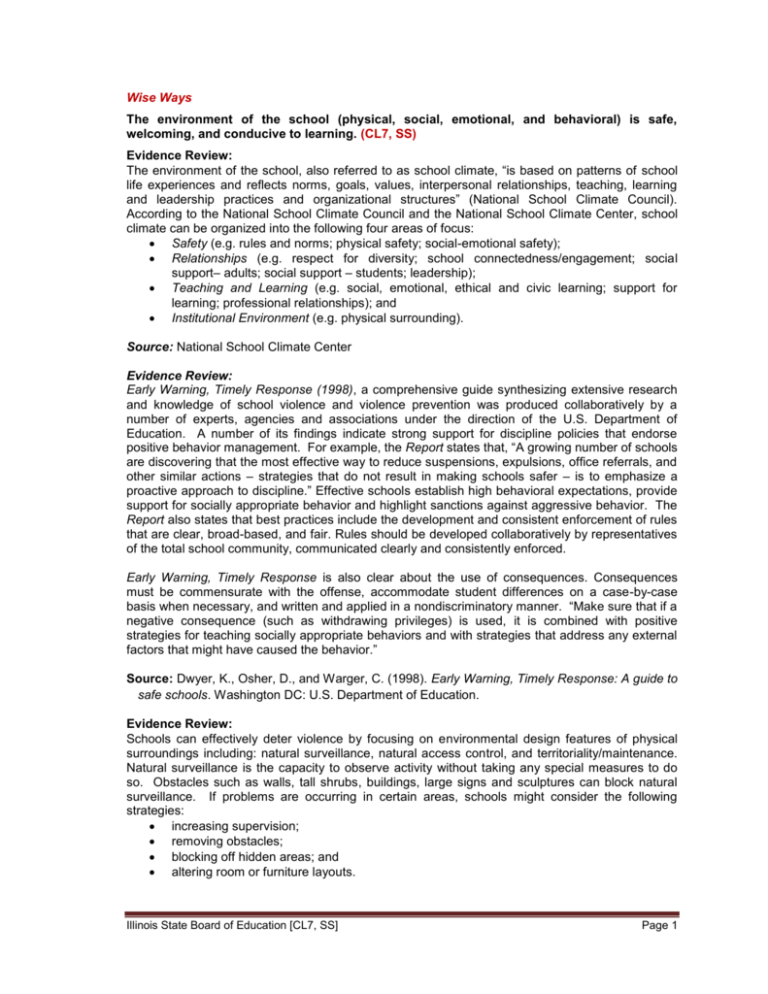
Wise Ways The environment of the school (physical, social, emotional, and behavioral) is safe, welcoming, and conducive to learning. (CL7, SS) Evidence Review: The environment of the school, also referred to as school climate, “is based on patterns of school life experiences and reflects norms, goals, values, interpersonal relationships, teaching, learning and leadership practices and organizational structures” (National School Climate Council). According to the National School Climate Council and the National School Climate Center, school climate can be organized into the following four areas of focus: Safety (e.g. rules and norms; physical safety; social-emotional safety); Relationships (e.g. respect for diversity; school connectedness/engagement; social support– adults; social support – students; leadership); Teaching and Learning (e.g. social, emotional, ethical and civic learning; support for learning; professional relationships); and Institutional Environment (e.g. physical surrounding). Source: National School Climate Center Evidence Review: Early Warning, Timely Response (1998), a comprehensive guide synthesizing extensive research and knowledge of school violence and violence prevention was produced collaboratively by a number of experts, agencies and associations under the direction of the U.S. Department of Education. A number of its findings indicate strong support for discipline policies that endorse positive behavior management. For example, the Report states that, “A growing number of schools are discovering that the most effective way to reduce suspensions, expulsions, office referrals, and other similar actions – strategies that do not result in making schools safer – is to emphasize a proactive approach to discipline.” Effective schools establish high behavioral expectations, provide support for socially appropriate behavior and highlight sanctions against aggressive behavior. The Report also states that best practices include the development and consistent enforcement of rules that are clear, broad-based, and fair. Rules should be developed collaboratively by representatives of the total school community, communicated clearly and consistently enforced. Early Warning, Timely Response is also clear about the use of consequences. Consequences must be commensurate with the offense, accommodate student differences on a case-by-case basis when necessary, and written and applied in a nondiscriminatory manner. “Make sure that if a negative consequence (such as withdrawing privileges) is used, it is combined with positive strategies for teaching socially appropriate behaviors and with strategies that address any external factors that might have caused the behavior.” Source: Dwyer, K., Osher, D., and Warger, C. (1998). Early Warning, Timely Response: A guide to safe schools. Washington DC: U.S. Department of Education. Evidence Review: Schools can effectively deter violence by focusing on environmental design features of physical surroundings including: natural surveillance, natural access control, and territoriality/maintenance. Natural surveillance is the capacity to observe activity without taking any special measures to do so. Obstacles such as walls, tall shrubs, buildings, large signs and sculptures can block natural surveillance. If problems are occurring in certain areas, schools might consider the following strategies: increasing supervision; removing obstacles; blocking off hidden areas; and altering room or furniture layouts. Illinois State Board of Education [CL7, SS] Page 1 Natural access control is the capacity to limit entry to a facility. Strategies to limit access include: re-configuring doors so that they automatically lock when closed and only serve as emergency exits; and replacing or re-configuring windows so that they can’t be used as entry points for people or contraband. It is important to note that every occupied space still needs two points of egress. Territoriality is the capacity to establish authority over an environment. reinforced through: prominently displaying signs; defining clear borders such as a low fence or hedge; and maintaining the campus. Territoriality can be Source: Schneider, T (2010). Crime Prevention through Environmental Design — The Fundamentals for Schools. Evidence Review Enhancing student engagement has emerged as a significant variable in school completion. Belonging, participation, identification, and school membership describe aspects of engagement and illustrate social and emotional factors necessary for academic learning (Zins et.al). Student engagement requires psychological connections within the academic environment e.g., positive adult-student and peer relationships. McPartland (1994) suggest four broad intervention components to enhance student engagement: providing opportunities for success in schoolwork, creating a caring school and supportive environment, communicating the relevance of education to future endeavors, and helping students with personal problems within the school environment. The following factors impact engagement in learning: 1. School Policies and Practice - School practices and policies such as tracking, retention, suspension, and rigid rule structures negatively affect student engagement, whereas policies and practices such as smaller schools, opportunities for creativity as student choice, and highlighting the relevance of curricula to personal life goals enhance levels of engagement 2. Schools with Caring Classroom Environments - Evidence shows that schools with committed faculty, positive teacher-student relationships, orderly, warm and caring supportive environments are associated with greater academic success. In addition, teaching practices that foster student autonomy, student participation and feeling of competence are also critical (MCPartland 1994). 3. Relationships Between Students - Students who are more socially integrated have a greater sense of belonging than those with less peer acceptance. 4. Family Support and Involvement - Students who perceive greater parental support i.e. discussion about school, less monitoring of homework but greater academic resource in the home have greater success in school. MCPartland, 1994 References and Other Resources: McPartland, J.M. (1994). Dropout prevention in theory and practice. In R,J. Rossi(ED.). Schools and Students at Risk: Context and framework for positive change (pp 255-276. New York: Teacher College Press. Stillwell, R., Sable, J., and Plotts, C., (2011). Public School Grades and Dropout from the Common Core Data: School year 2008-09(NCES 2011-3112). U.S. Department of Education, Washington, D.C.: National Center for Education Statistics, Retrieved (5/11) from http://nces.ed.gov/pubsearch. Zins, Joseph E. (Eds.) (2004) Building academic success on social and emotional learning: what does the research say? New York: Teachers College Press. Example: Illinois State Board of Education [CL7, SS] Page 2 A short-term longitudinal study of urban middle school students revealed that students’ perception of their school environment impacted their perceptions the following year which in turn impacted engagement and academic achievement. This study specifically looked at the impact that perceptions of the school environment had on behavioral, emotional, and cognitive engagement. “Behavioral engagement refers to the actions and practices that students direct toward school and learning; it includes positive conduct (e.g., attending class and completing schoolwork), involvement in learning and academic tasks (e.g., effort and concentration), and participation in extracurricular activities (Finn, 1993; Finn, Pannozzo, & Voelkl, 1995). Emotional engagement represents a student’s affective reactions and sense of identification with school (Skinner & Belmont, 1993). Cognitive engagement refers to a student’s self-regulated and strategic approach to learning (Fredricks et al., 2004). These three components are dynamically interrelated within individuals and are not isolated processes.” Findings from the study related to engagement included: 1. Students were more likely to have a positive identification with school and participate in their tasks when teachers offered positive and improvement-based praise and emphasized effort while avoiding pressuring students for correct answers or high grades. 2. Competitive learning environments decreased school participation, undermined the development of a sense of school belonging, and diminished the value students placed on school. 3. In order to become engaged with learning, students who are competent but either alienated from school or less intrinsically motivated may need more autonomy support in the form of more interesting and relevant activities and decision-making opportunities. 4. Students who are passive or anxious about exercising autonomy or attempting novel tasks may need more structured scaffolding of tasks, more guidance, and more explicit instruction in effective strategies to become fully engaged with classroom learning. 5. Students reported higher levels of school identification and use of self-regulatory strategies when they were encouraged to interact and discuss ideas with each other in class. 6. When teachers create a caring and socially supportive environment, students are more likely to participate in school and bond with school. In addition, there was empirical support for their hypotheses that perceptions of school environment would impact behavioral, emotional, and cognitive engagement in school, which would in turn influence students’ academic achievement. In this study, the emotional component was particularly influential on students’ academic achievement. Source: Wang & Holcombe (2010). Adolescents' perceptions of school environment, engagement, and academic achievement in middle school. References and Other Resources: Finn J. D. (1993). School engagement and students at risk. Washington, DC: National Center for Education Statistics. Finn J. D., Pannozzo G. M.,Voelkl K. E. (1995). Disruptive and inattentive-withdrawn behavior and achievement among fourth graders. Elementary School Journal, 95, 421–454. Fredricks J. A., Blumenfeld P. C., Paris A. H. (2004). School engagement: Potential of the concept, state of the evidence. Review of Educational Research, 74, 59–109. Skinner E. A., Belmont M. J. (1993). Motivation in the classroom: Reciprocal effect of teacher behavior and student engagement across the school year. Journal of Educational Psychology, 85, 571–581. Evidence Review: Teachers who are supportive (i.e., show care and concern for their students’ well being and learning) and emotionally well regulated are able to provide students with a safe and caring learning environment that is conducive to students’ social, emotional, behavioral, and academic development. When teachers exhibit negative affect and have poor relationships with their students, feelings of alienation and disengagement are likely to occur. When students experience Illinois State Board of Education [CL7, SS] Page 3 these negative feelings and disengage, they are at greater risk of developing antisocial behaviors, delinquency, and academic failure (U.S. Department of Education, 1998). Teachers often report greater stress when they have disruptive students in their classroom (Yoon, 2002) and tend to express negative emotions in response to student misbehavior (Carson & Templin, 2007; Hamre & Pianta, 2001; Pianta et al., 2003; Sutton & Wheatley, 2003). “Hamre and Pianta (2001) found that kindergarten teachers’ reports of negative affect in relation to a student were meaningful predictors of student social and academic outcomes through at least fourth grade.” However, students who have supportive relationships with their teachers tend to feel safe and connected which provides the necessary social supports that promote social and emotional development and academic success. Source: The Prosocial Classroom: Teacher Social and Emotional Competence in Relation to Student and Academic Outcomes References and Other Resources: Carson, R. L., & Templin, T. J. (2007). Emotion regulation and teacher burnout: Who says that the management of emotional expression doesn't matter? Paper presented at the American Education Research Association Annual Convention, Chicago, IL. Hamre, B., & Pianta, R. C. (2001). Early teacher-child relationships and trajectory of school outcomes through eighth grade. Child Development, 72(625-638). Pianta, R. C., Hamre, B., & Stuhlman, M. (2003). Relationships between teachers and children. In W. M. Reynolds & G. E. Miller (Eds.), Comprehensive handbook of psychology (Vol.7). New York: Wiley. Sutton, R. E., & Wheatley, K. E. (2003). Teachers' emotions and teaching: A review of the literature and directions for future research. Educational Psychology Review, 15, 327-358. Yoon, J. S. (2002). Teacher characteristics as predictors of teacher-student relationships: Stress, negative affect, and self-efficacy. Social Behavior and Personality, 30, 485-493. Example: In a study by Hughes, Cavell, and Willson (2001), the impact of teacher-student relationships on peer preference of aggressive students was examined. The study revealed that teacher support uniquely predicted peer preference within the aggressive students. “This suggests that peer perception of teacher support had a buffering effect on peers’ social preference of aggressive students and that students take cues from their teacher in determining whether a peer is likable or not. This finding has implications for intervention strategies for improving the social status of rejected and aggressive students. Interventions that directly target the teacher-student relationship by promoting SEC may enable teachers to offer support to students despite their troubling behavior and may make a difference in student social status among peers contributing to their feeling of connectedness with the school community.” Source- The Prosocial Classroom: Teacher Social and Emotional Competence in Relation to Student and Academic Outcomes References and Other Resources: Hughes, J. N., Cavell, T. A., & Willson, V. (2001). Further support for the developmental significance of the quality of the teacher-student relationship. Journal of School Psychology, 39, 289-301. Evidence Review: The Leadership Team maintains a school culture that is friendly, supportive, and focused on children’s learning. The Leadership Team provides training and guidance for non-certified and support staff so they understand the school’s purpose and their role in it, greet visitors cordially, and interact positively with students. Source: Academic Development Institute, Effective Teaming Illinois State Board of Education [CL7, SS] Page 4 Evidence Review: 1. The school telephones are answered by staff who are pleasant, cheerful, and helpful. 2. All staff—including teachers, teachers’ aides, clerks, custodians, cooks, and others—greet visitors in the hallway in a pleasant and helpful manner, to solicit their needs, and to direct them to the office. 3. Office staff greet visitors promptly, cheerfully, and helpfully. 4. We have a written policy regarding visits by parents to their children’s classrooms. Our policy includes: • a provision that advance permission is requested, • procedures to notify the teacher, • a friendly hand-out for visiting parents to explain their role in the classroom—where they should sit and what the teacher will expect them to do, and • guidelines for teachers to greet parents warmly and explain to them what is going on in the classroom. 5. The signs that greet visitors outside our doors and in our hallways are friendly while also being clear about our expectation that visitors register in the office. Helpful signs pointing to the office are placed on hallway walls. 6. Our school provides special attention to welcome families that are new to the school. 7. Our school has clear expectations of all school staff that they address students and parents respectfully. 8. Our school makes every effort to minimize interruptions in the classrooms, including the frequency of announcements. Source: Academic Development Institute, Solid Foundation School Community Council Planning Guide Illinois State Board of Education [CL7, SS] Page 5
